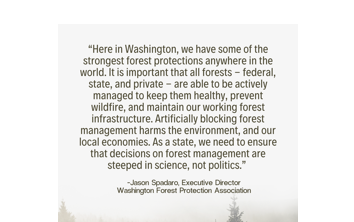“Removing these acres from sustainable harvest will mean less revenue for schools, fire districts, hospitals, and libraries that depend on trust land funds, and fewer family-wage jobs in Washington’s forest sector,” said AFRC President Travis Joseph. “This immediate set-aside represents an estimated $300 million loss in revenues for trust land beneficiaries and a $1 billion hit to Washington’s forest products sector. We are hopeful that the Legislature and Board of Natural Resources will closely scrutinize this proposal and press Commissioner Upthegrove to move forward with releasing timber sales that have been stalled during his pause, so beneficiaries and the forest sector can begin to recover from months of lost revenue.”On his first day in office, Commissioner Upthegrove froze roughly two dozen pending timber sales, a “pause” that lasted eight months and drove the Department of Natural Resources’ (DNR) timber program to its lowest output in 20 years. By the end of Fiscal Year 2025, DNR sold just 389 million board feet of timber — nearly 200 million board feet short of plan — costing trust beneficiaries an estimated $60–$70 million in revenue and costing the agency $25 million in lost management fees used for field work, silviculture, and other expenses.
The first 24 paused sales alone represented nearly 80 million board feet of timber worth about $44 million, enough to build 5,000 homes. With FY 2026 now underway, DNR is on track for a record-low first quarter, offering just 21 million board feet compared to the 119 million board feet it had planned.
Commissioner Upthegrove claimed the pause was necessary to ensure that DNR was on track to meet expectations of its Habitat Conservation Plan (HCP) for developing structurally complex forests. But the data obtained through a public records request confirmed that DNR is already on track to meet the expectation for 10 to 15 percent older, structurally complex forests in each HCP planning unit.
In fact, the agency is decades ahead of schedule based on acres already set aside from harvest under the HCP, with 15.1 percent of state trust lands already in structurally complex conditions, exceeding the conservation expectation identified in the HCP as well as the direction set by the Board of Natural Resources’ Policy for Sustainable Forests. This should also satisfy Commissioner Upthegrove’s concerns about DNR’s progress towards meeting this outcome.
Under Washington’s Constitution, and state and federal laws, DNR state trust lands are managed to generate revenue for trust land beneficiaries. Each timber sale also sets in motion activity that supports local family-owned logging companies, truckers, and sawmills that provide good-paying jobs in rural communities. By law, timber harvested from state trust lands must be manufactured domestically, keeping the economic benefits in Washington.
DNR state trust lands help provide much-needed lumber and other products at mills that supply essential building materials for housing and infrastructure like utility transmission poles. Sustained-yield forest management also ensures a continued, renewable supply of climate-friendly wood products, which store carbon, reduce reliance on imports, and support the state’s climate and wildfire resilience goals.
“DNR is already achieving its mature forest conservation goals,” Joseph said. “By removing these lands from the working forest base, Commissioner Upthegrove is putting politics over the state constitution, the needs of trust land beneficiaries, and the needs of rural communities. We urge the Board of Natural Resources and the Legislature, which will likely be on the hook to backfill this revenue, to provide oversight, clarity and stability so beneficiaries, communities, and Washington’s forest sector can plan for the future.”
Contact: Nick Smith, 503-515-4206 or nsmith@amforest.org
